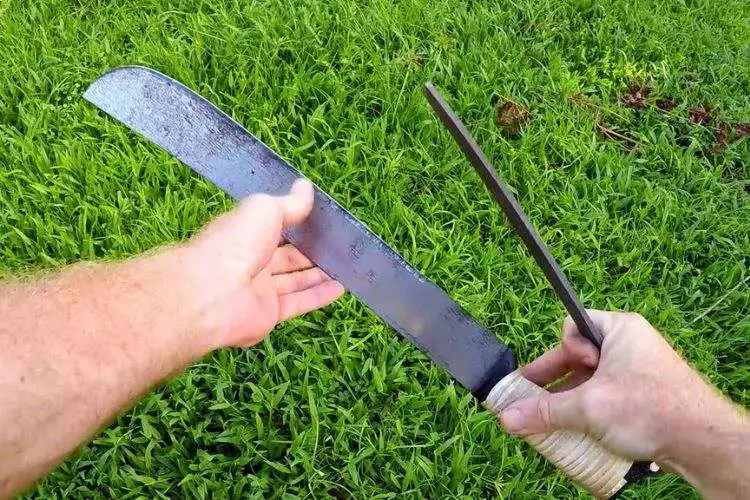Machetes, known for their versatility in outdoor activities and survival situations, raise a common question: just how sharp do machetes need to be?
In this article, we dive into exploring this topic, understanding the correlation between the sharpness of a machete and its functionality.
Whether you’re a seasoned outdoor enthusiast, a gardener, or someone fascinated by survival tools, gaining insight into the optimal sharpness of a machete will be useful.

From slicing through dense undergrowth or preparing a campfire meal, we cover why the sharpness of your machete matters. Join us on this cutting-edge discussion.
How Sharp Do Machetes Need to Be?
The ideal sharpness of a machete depends on its intended use, but generally, it should be sharp enough to cut through vegetation and other materials with relative ease while not being as razor-sharp as a kitchen knife or a scalpel.
For agricultural tasks like clearing brush or chopping through fibrous plants, a machete should have a sharp edge, akin to the sharpness of a standard pocket knife, that allows for efficient cutting without getting lodged in the material.
A too-sharp edge is more prone to chipping when it strikes hard materials, while a dull edge requires more force and can lead to user fatigue or injury.
For wood chopping or carving, a slightly less sharp edge but with a well-maintained bevel will retain its edge longer and be more durable. The blade should be sharp enough to bite into wood without too much effort, but it need not be sharp enough to easily slice paper.
In survival situations, a medium sharpness is versatile, balancing cutting ability with edge resilience. The machete will need to perform a wide range of tasks, potentially including food preparation for which you would want a cleaner cut, but still durable enough to withstand the varied and repeated impacts with wood and bone.
Keep in mind that the sharpening angle plays a role; a 20-25 degree angle per side is typical for a good all-purpose machete. Regular maintenance of the blade edge is crucial to ensure the machete performs its best, regardless of the specific sharpness.
Machete Sharpening Techniques
Sharpening a machete is a skill that enhances the tool’s functionality and longevity. Several techniques can be employed to maintain the cutting edge of a machete, each suited to different needs and levels of existing wear on the blade.

Using a File
One of the most common methods for sharpening a machete is using a metal file. This technique is particularly effective for restoring a dull or nicked edge.

- Secure the Machete: Begin by securing the machete in a vise or with clamps to a stable work surface to prevent movement while you’re working on it.
- Choose the Right File: Use a bastard file for the job, which is coarse enough to grind away metal without removing too much material.
- Match the Bevel Angle: Maintain the existing bevel angle; this is typically between 20-25 degrees. Place the file on the edge of the blade and tilt it to match this angle.
- File with Consistent Strokes: Push the file along the blade in a motion away from your body. Use even and consistent pressure. After several passes, check the edge and repeat until you’ve achieved the desired sharpness.
Whetstone Sharpening
Whetstones, or sharpening stones, come in various grits and can be used for both initial sharpening and polishing the edge of a machete.
- Soak or Lubricate the Stone: Depending on the type of stone (oil or water), it may need to be soaked or lubricated before use.
- Start with Coarser Grit: Begin with the coarser grit side of the stone if the edge is very dull or damaged. Place the stone on a non-slip surface for safety.
- Sharpen the Edge: Holding the blade at the same angle as the bevel, glide the machete’s edge across the stone in a sweeping motion that covers the length of the blade. Repeat this process, maintaining consistent angle and pressure.
- Switch to Finer Grit: Once you’ve achieved a good edge, flip the stone to the finer grit side to hone and polish the edge.
- Maintain a Consistent Angle: Consistency in maintaining the correct angle is crucial. Frequent angle changes will round the edge and lead to suboptimal sharpness.
Honing Rods
Honing rods don’t necessarily sharpen but are essential for straightening the edge of the blade, which is crucial for maintaining sharpness between more thorough sharpening sessions.
- Select a Rod: Choose a honing rod that is as long as your machete to ensure you can stroke the entire length of the blade.
- Hold the Rod Securely: Place the tip of the rod on a non-slip surface, holding the handle with one hand and the machete in the other.
- Stroke the Blade Along the Rod: With the blade at the established angle to the rod, run it down the length of the rod from the hilt to the tip. Do this for both sides of the blade equally to maintain balance.
Technique Tips for All Methods
- Inspect the Edge: Before starting any sharpening process, inspect the blade for chips or dents to determine the amount of work needed.
- Go Slow and Stay Safe: Always use slow, controlled movements to avoid injury. Work gloves and eye protection are advised.
- Test the Sharpness: After sharpening, test the blade on a piece of paper or vegetation. It should slice through easily without requiring excessive force.
- Clean the Blade: After you finish sharpening, clean the blade thoroughly to remove any metal filings and residue.
Remember, the goal of sharpening a machete is not to achieve a razor-like edge but to have a functional and durable cutting tool suited for its intended use. Regular maintenance will keep the machete performing efficiently and preserve its life for years to come.
Choosing the Right Machete for Your Needs
A machete is a versatile tool used across the globe for a variety of outdoor and agricultural tasks. Selecting the right type depends on the nature of the work you intend to use it for, as well as personal preference for weight, handle type, and blade design.

Here is an exploration of different machete types, their unique features, and the tasks they are best suited to accomplish.
Bolo Machete
The Bolo Machete has a distinctive bulbous tip that adds weight to the front of the blade. This design enhancement is intended for agricultural use, such as chopping thick and woody vegetation.
Its weighted front makes it ideal for tasks that require a bit of heft, especially for cutting and mowing. Due to its design, maintaining a sharp edge is crucial, especially towards the tip, to make the most of its chopping potential.
Panga Machete
Popular in Africa and the Caribbean, the Panga Machete features a deep, curved blade that broadens towards the tip. It is designed to cut through thick brush and for chopping foods and meats.
The curvature allows for efficient slicing, necessitating sharpness that is consistent along the curve for optimal performance.
Kukri Machete
The Kukri, with origins in Nepal, has a unique, inwardly curved blade that is effective for both chopping and carving tasks. The design lends itself to versatility in use—from clearing brush to cutting meat.
The sharpness of a Kukri must be maintained from the curve all the way to the tip to ensure effectiveness across its multiple uses.
Parang Machete
The Parang Machete, found commonly in Southeast Asia, features a slightly curved blade that tapers evenly from handle to tip.
It’s designed primarily for cutting through dense forest vegetation without getting caught or lodged into the material. A uniformly sharp edge is vital for the Parang, allowing smooth, slicing cuts through resistance.
Barong Machete
The Barong Machete has a leaf-shaped blade that offers a wide, cutting surface. This design is beneficial for slashing through thick vegetation. Its shape allows for a longer cutting edge but requires regular maintenance of its sharpness to efficiently cut without snagging.
Coping Machete
Coping Machetes are characterized by their thin, lightweight blades suited for finer tasks such as peeling fruit or carving wood. The finer tasks require a sharper edge, often requiring more frequent sharpening to maintain its precision cutting capability.
Sharpness Variability
Each machete type, by virtue of its design and intended use, demands a specific level of sharpness:
- Heavy-duty chopping machetes (like the Bolo) need a sharp edge that is durable and can withstand impact, but not so fine that it becomes prone to chipping.
- Slicing machetes (such as the Panga) benefit from a sharper edge to ensure clean cuts through material without needing excessive force.
- Carving or detail work machetes (like the Coping Machete) require the sharpest, most refined edge to execute precise cuts and detailed work.
- Maintenance of the edge is crucial across all types, but the frequency and sharpening technique may vary based on the blade’s purpose and the material it encounters.
Conclusion:
In summary, the requisite sharpness of a machete is greatly influenced by its intended use. Heavy chopping tasks demand a sturdy but moderately sharp edge to avoid chipping, while finer slicing and precision work necessitate a keener edge.
Regular maintenance using the correct sharpening techniques is key to upkeeping the tool’s effectiveness and safety. Ultimately, the aim is to have a machete that is sharp enough to perform its designated tasks efficiently, without being excessively sharp to the point of being fragile or dangerous for general use.


